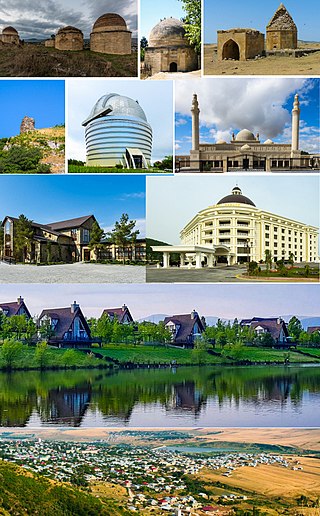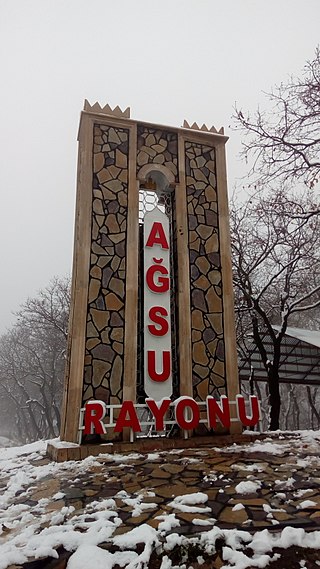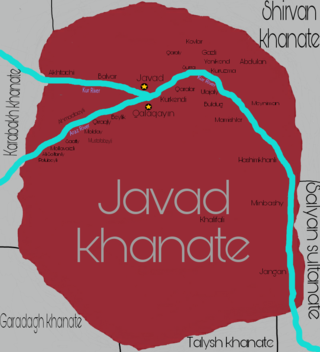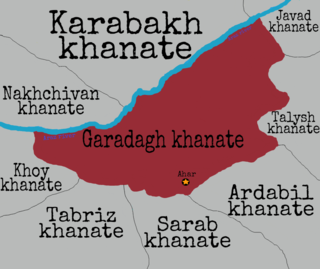Related Research Articles

Shaki is a city in northwestern Azerbaijan, surrounded by the district of the same name. It is located on the southern part of the Greater Caucasus mountain range, 240 km (150 mi) from Baku. As of 2020, it has a population of 68,400. The center of the city and the Palace of Shaki Khans were inscribed in the UNESCO World Heritage List in 2019 because of its unique architecture and its history as an important trading center along the Silk Road.

Hajigabul District is one of the 66 districts of Azerbaijan. It is located in the east of the country and belongs to the Shirvan-Salyan Economic Region. The district borders the districts of Kurdamir, Agsu, Shamakhi, Gobustan, Absheron, Baku, Salyan, Sabirabad and the city of Shirvan. Its capital and largest city is Hajigabul. As of 2020, the district had a population of 76,600.

Shamakhi District is one of the 66 districts of Azerbaijan. It is located in the east of the country and belongs to the Mountainous Shirvan Economic Region. The district borders the districts of Quba, Khizi, Gobustan, Hajigabul, Agsu, and Ismayilli. Its capital and largest city is Shamakhi. As of 2020, the district had a population of 106,400.

Shamakhi is a city in Azerbaijan and the administrative centre of the Shamakhi District. The city's estimated population as of 2010 was 31,704. It is famous for its traditional dancers, the Shamakhi Dancers, and also for perhaps giving its name to the Soumak rugs.

Shirvan Khanate was a Caucasian khanate under Iranian suzerainty, which controlled the Shirvan region from 1761 to 1820.

The Erivan Khanate, also known as Chokhur-e Sa'd, was a khanate that was established in Afsharid Iran in the 18th century. It covered an area of roughly 19,500 km2, and corresponded to most of present-day central Armenia, the Iğdır Province and the Kars Province's Kağızman district in present-day Turkey and the Sharur and Sadarak districts of the Nakhchivan Autonomous Republic of present-day Azerbaijan.

Seyid Azim Shirvani was an Azerbaijani poet and enlightener. He got his first religious education in Iraq. After returning to motherland he refused his spiritual dignity and opened a private school. Seyid Azim Shirvani continued Fuzûlî’s traditions in his love-lyrical poems. In his satirical poems and fables Seyid Azim Shirvani ridiculed priesthood, opposed backwardness and ignorance, called to enlightenment and culture. Contemporary poets consider him their teacher.

Agsu is a city in and capital of the Agsu District of Azerbaijan.
Fatali Khan or Fath Ali Khan of Quba was a khan of the Quba Khanate (1758–1789) who also managed to dominate the Derbent, Baku, Talysh and Shirvan Khanates, as well as the Salyan Sultanate during much of his reign.

Mahammad Hadi or Agha-Mahammad Haji-Abdulsalim oglu Abdulsalimzade was an Azerbaijani romanticist poet.
Hajji Mohammad Ali Khan was the first khan (governor) of the Shirvan Khanate, ruling from 1761 to 1763. With the permission of the Zand ruler Karim Khan Zand, he was put in power by the inhabitants of Old Shamakhi. He governed Shirvan until 1763, when Fath-Ali Khan of Quba gained influence there, and appointed his own governors, such as Aghasi Beg and Askar Beg, both members of the same family.
Aghasi Khan (1731–88) was second Khan of Shirvan Khanate along with his brother Muhammad Said Khan. He was of nomadic tribe of Khanchobani.

Javad Khanate was a khanate in the territory of modern Azerbaijan with its capital in the town of Javad. It extended from Javad on the Kura River southwest along the east side of the Aras River. It was bordered by Shamakhy Khanate (north), Karabakh Khanate (west), Karadagh khanate (southwest), Talysh Khanate (south), and Salyan Sultanate (east).
Beyt-us-safa was a literary council which was first held in the 19th century in Azerbaijan.

Karadagh Khanate, was a khanate established in the 18th century, with its capital at Ahar.
House of Sarkar was ruling clan of Shirvan Khanate from Khanchobany tribe. "Sarkar" means "tax collector", which can give clues about profession of progenitor.

Baku Khans' Palace is a complex of several houses that belonged to the members of the ruling family of the Baku Khanate.
Mirza Muhammad Khan I was the founding Khan of the Baku Khanate. He was a descendant of the Iranian garrison commander of Baku of 1723.

Hasan Ali Khan Garadaghi or Hasanali khan Karadakhski, was an Azerbaijani philologist, writer, poet and teacher. He is mainly known for his contribution to "Vatan dili" which was the main textbook for Azerbaijani school children for almost 40 years, from 1882 to 1920.
Muhammad Husayn Khan Mushtaq, was the third khan of Shaki. He was described as a courageous but ruthless man by Abbasgulu agha Bakikhanov.
References
- ↑ "Azərbaycan :: Baş səhifə". azerbaijans.com.